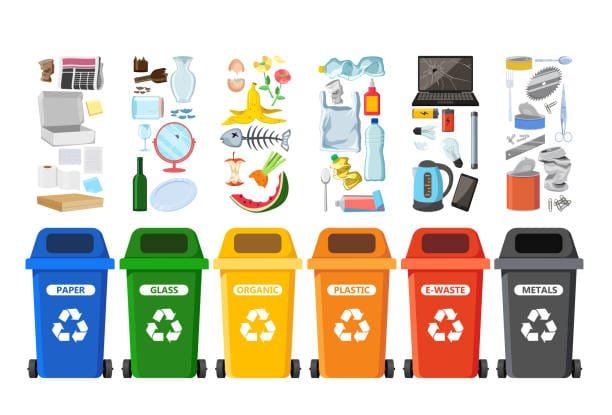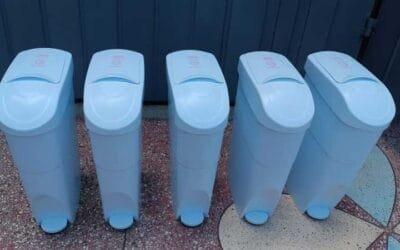Introduction
Ever paused for a second before tossing something into the trash and thought, “Wait, which bin does this go into?” You’re not alone! Waste bins may seem like mundane containers, but they’re at the heart of clean living and environmental sustainability. From our kitchens to public parks, the right waste bin ensures that garbage goes to the right place.
A well-organized waste disposal system not only maintains hygiene and reduces environmental hazards but also simplifies recycling and waste treatment processes. And it all starts with the humble bin.
Let’s dive into the world of waste bins and explore their many forms, uses, and how they make our lives—and our planet—healthier and more organized.
General Classification of Waste Bins
Dry Waste vs Wet Waste Bins
This is where waste management begins—at the point of sorting between wet and dry.
- Wet Waste Bins handle food scraps, vegetable peels, tea bags—basically anything organic and biodegradable.
- Dry Waste Bins are for paper, plastics, metals, and other recyclables that don’t decompose easily.
Sorting waste at the source prevents mess, reduces odors, and boosts recycling rates. Simple steps, big impact.
Biodegradable vs Non-Biodegradable Waste Bins
Understanding how waste breaks down helps you choose the right bin:
- Biodegradable waste bins are designed for materials that rot and return to nature quickly, like leftover food, leaves, or biodegradable packaging.
- Non-biodegradable bins are used for items like plastic containers, foil, Styrofoam, and glass, which can take decades or centuries to decompose.
This separation is key to reducing landfill overload and encouraging composting.
Residential Waste Bins
Indoor Waste Bins
Kitchen Bins
The MVP of the house. A good kitchen bin should have:
- A tight lid to contain odors
- A foot pedal for hands-free use
- Twin compartments for separating wet and dry waste
In modern kitchens, you’ll often find sleek bins with built-in liners and odor filters.
Bathroom Bins
Small, discreet, and often lidded. These bins are used to dispose of:
- Sanitary products
- Tissue paper
- Small packaging waste
Hygiene is crucial here—look for bins with antimicrobial surfaces or deodorizing lids.
Outdoor Household Bins
Wheelie Bins
Those large, colorful bins with wheels are used for weekly curbside pickup. Most households get a set that includes:
- A bin for recyclables
- One for organic waste
- Another for general trash
They’re built to handle large volumes and weather extremes.
Compost Bins
Ideal for gardeners and eco-warriors. These bins store:
- Vegetable peels
- Fruit waste
- Garden clippings
They convert waste into rich compost, perfect for backyard gardens and potted plants.
Commercial Waste Bins
Office Waste Bins
Usually, small, inconspicuous bins are placed under desks or in communal areas. Offices commonly use:
- Paper recycling bins
- Confidential waste bins (shredding)
- Multi-bin stations for sorting
Eco-conscious offices now encourage waste segregation with signage and incentives.
Restaurant and Hospitality Bins
These bins must be:
- Hygienic and lidded
- Clearly labeled
- Often color-coded
They handle both organic waste (like leftover food) and dry packaging materials (like plastic wrap or cardboard).
Industrial Waste Bins
Heavy-duty environments need heavy-duty solutions.
Construction & Factory Bins
These bins are often:
- Made of metal
- Mounted on wheels or forklifts
- Used for debris, scrap materials, or hazardous components
Some bins are fireproof or designed to hold sharp, corrosive, or heavy waste.
Specialized Waste Bins
Medical Waste Bins
Sharps Containers
Puncture-proof and leak-proof, these bins safely hold:
- Used needles
- Syringes
- Scalpels and other sharp instruments
Crucial for healthcare settings to avoid injury and contamination.
Biohazard Bins
These bins are bright red or yellow and marked with a biohazard symbol. They are used for:
- Blood-soaked items
- Tissues and organs
- Infectious waste
Strict handling and disposal rules apply.
E-Waste Bins
With tech evolving quickly, e-waste is rising fast. These bins collect:
- Old phones
- Batteries
- Chargers
- Small electronic devices
Proper disposal prevents heavy metal contamination and allows valuable materials to be recovered.
Sanitary Waste Bins
Found in restrooms, especially in female bathrooms. These are specifically designed for:
- Pads and tampons
- Diapers
- Incontinence products
Often fitted with a cover and sometimes contain deodorizing elements.
Hazardous Chemical Waste Bins
Used primarily in:
- Laboratories
- Paint shops
- Cleaning facilities
These bins are clearly labeled and made from materials resistant to corrosive or toxic substances.
Public Waste Bins
Park and Street Bins
Public spaces need bins that are:
- Sturdy and weatherproof
- Theft- and tamper-resistant
- Often bolted to the ground
They help keep litter off the streets and encourage civic pride.
Recycling Station Bins
These bins are set up in:
- Malls
- Schools
- Event venues
They feature multiple compartments for sorting plastic, glass, metal, and paper.
Smart Bins in Smart Cities
The future of waste disposal is here.
What Are Smart Bins?
Smart bins include features such as:
- Sensors to detect when the bin is full
- GPS to track location
- Compacting mechanisms to increase bin capacity
- Auto-alerts that notify municipal authorities
These are particularly useful in high-traffic public spaces to avoid overflows.
Segregated Waste Bins by Color
Color coding makes waste segregation intuitive.
| Color | Waste Type |
|---|---|
| Green | Organic/Biodegradable waste |
| Blue | Dry recyclables (paper, plastic) |
| Red | Sanitary waste |
| Yellow | Medical waste |
| Black/Grey | General waste (non-recyclable) |
By simply following color codes, people can instantly reduce contamination and promote recycling.
Materials Used in Waste Bins
Plastic Bins
- Lightweight
- Budget-friendly
- Easy to clean
- Best for homes and low-risk areas
Metal Bins
- Fire-resistant
- Durable
- Great for kitchens, factories, and commercial use
Stainless Steel Bins
- Sleek and rust-proof
- Common in hospitality and upscale homes
Biodegradable Bins
- Made from cornstarch, bamboo, or recycled paper
- Great for events or environmentally-conscious households
Smart and Technological Advancements in Waste Bins
Sensor Bins
These open automatically when your hand approaches. Great for:
- Kitchens
- Hospitals
- Public restrooms
App-Connected Bins
- Track your waste generation
- Offer sorting guides
- Sync with local recycling programs
Solar-Powered Compacting Bins
- Used in city centers
- Compress waste to increase holding capacity
- Notify sanitation teams when full
Choosing the Right Waste Bin
Before purchasing a bin, consider the following:
- Capacity: Choose based on the volume of waste generated.
- Placement: Should be accessible but discreet.
- Material: Match your needs—plastic for light use, metal for heavy-duty.
- Compartments: Multi-compartment bins promote easy segregation.
Importance of Waste Bin Labeling and Signage
Clear labels prevent confusion. Effective signage includes:
- Icons (e.g., apple core for organic)
- Bilingual text
- Color coding
- Size and font clarity
This helps children, tourists, and the elderly dispose of waste correctly.
Waste Bin Maintenance and Hygiene Tips
To keep your bins in top condition:
- Empty regularly to avoid odors and pests
- Disinfect weekly with mild bleach or vinegar
- Use liners to reduce mess and simplify disposal
- Keep lids closed to prevent pest infestation
- Replace damaged bins to maintain hygiene standards
Conclusion
Whether it’s a tiny bin under your desk or a solar-powered beast in a city square, waste bins are silent heroes. They help manage our mess, protect our health, and sustain the environment. Picking the right one—and using it correctly—goes a long way in keeping our homes, workplaces, and planet clean.
The world generates over 2 billion tons of waste each year. The least we can do? Use the right bin.
FAQs
1. What are the different color codes for waste bins?
Green is for organic, blue for recyclables, red for sanitary, yellow for medical, and black for general waste.
2. How do smart bins work?
They use sensors to detect waste levels, open automatically, and sometimes compact waste. Some even notify collection services.
3. Can I mix biodegradable and non-biodegradable waste?
Nope! Keep them separate to allow proper composting and recycling.
4. Why is waste segregation important?
It ensures recyclables aren’t contaminated and reduces landfill burden. Plus, it saves energy and resources.
5. What is the best type of bin for a home kitchen?
A dual-compartment, pedal-operated bin is ideal for separating wet and dry waste while keeping things hygienic.
👉 Browse our wide range of high-quality waste bins here and find the perfect solution for your home, office, or facility today!




0 Comments